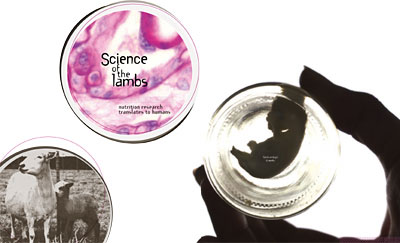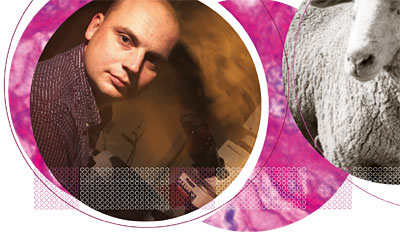
For months, doctoral candidate Pawel Borowicz has spent hours each week in a Hultz Hall laboratory, laboring over a computer image.
The picture, composed of lurid pools of fuchsia and blue, resembles a Doppler radar map gone bad. Like what would happen if a blizzard-spewing tornado cleaved right through the heart of a hurricane.
In fact, the image represents something much smaller, and much less catastrophic, than some nightmarish weather system. It actually shows the humble placenta of a ewe - the vivid whorls of color delineating not snow crystals or hailstones, but vessels and tissues.
Borowicz is using a sophisticated image-analysis program to count blood vessels, which are important in determining fetal health. By the ninth month, a healthy placenta will resemble a Los Angeles road map - a complex network of vessels shipping nourishment to the fetus. But if fetal development is compromised, the channels will be far fewer - more like a map of Wyoming. So Borowicz is creating a baseline image of a healthy uterine lining, from which comparisons can be drawn.
His work is just one piece of the university's new Center for Nutrition and Pregnancy, a consortium of national and international research institutions that will generate data on the ever-growing field of prenatal and postnatal nutrition.
While most of the collaborators' work is done on sheep, the benefits of their efforts aren't limited to one species.
Scientists can learn a lot about pregnancy in humans - the effects of certain nutrients on placental growth, the dangers of eating too much or subsisting on Diet Coke - by studying those conditions in sheep first.
Sheep make ideal guinea pigs for several reasons. They are just the right size to house and feed. They share many important reproductive similarities with humans, such as a tendency to bear singletons. And they also are an excellent model for the other ruminant species of the Upper Great Plains, which is useful for animal science research.
"We're excited because our data cuts both ways," says Joel Caton, an animal science professor and co-director of the center. "It answers producers' questions from a livestock standpoint, and it also answers human health questions..
The partnership not only melds expertise and knowledge, it also gives the assorted centers a large, prestigious umbrella under which they can seek large, prestigious grants. "It's a way to formalize a lot of collaborations that had developed 15 years ago or so," says Larry Reynolds, also an animal science professor and the center's other co-director.
Among the collaborators are the University of Wyoming, New Mexico State University and three USDA centers: the Human Nutrition Research Center in Grand Forks, the U.S. Sheep Experiment Station in Dubois, Idaho, and the Biosciences Laboratory in Fargo.
A sixth partner, the Rowett Research Institute for Nutrition in Aberdeen, Scotland, boasts three Nobel laureates and a worldwide reputation for its work in human nutrition.
All of these collaborators, scattered thousands of miles apart, are drawn together by two men who couldn't seem more different.
Caton is compact, dark-haired, clean-shaven and high-energy; Reynolds is tall, graying, bearded and laid-back. Caton's speech is peppered with words like "Barker hypothesis" and "angiogenesis"; Reynolds prefers to explain science in a more general, everyman's language.
Although Caton's expertise is in nutrition and Reynolds' is in physiology, the two know how closely their disciplines are twined. Both professors understand that nutrition is never more important than in the womb, as it can determine an offspring's health, from its kidney function to the way it stores lipids, long after it enters the world.

The theory echoes a new discovery in the relatively young science of nutrition: The fact "nutritional insults" during pregnancy can program a fetus for problems later in life.
Case in point: At the Rowett Institute, center collaborator Jacqueline Wallace is studying the effects of overnutrition during pregnancy. Wallace and her team have re-created conditions like gestational diabetes in adolescent sheep by overfeeding them. Once their lambs were born, they had lower birth weights than the progeny of moderately fed sheep. The increased maternal tissue growth actually seemed to take place at the expense of placental growth.
Due to the animal's compressed life span, Wallace and her team now can track how those factors affect the lamb after birth, into adulthood - and after it gives birth to its own offspring.
Conversely, NDSU's joint animal studies with the University of Wyoming suggest an undernourished fetus has a higher incidence of obesity, high blood pressure and other health conditions as an adult.
"There are really some profound effects of nutrition during pregnancy on the offspring," Reynolds says. "In other words, many of the diseases we see in adults - cardiovascular problems, diabetes and other metabolic disorders, and reproductive problems - a pretty big proportion of those things have their origin during pregnancy..
One culprit, of course, is that many women are pregnant for weeks before they realize it. And if we've learned anything in the last couple of decades, it's that good nutrition is crucial in early pregnancy.
A woman needn't look farther than the next billboard to know she should take folic acid in the first trimester. But the medical world still doesn't fully understand the long-term effects of, say, mom's all-protein diet or substances like aspartame. Any of these areas, Reynolds says, would be ripe for study at the center.
Yet another major area of study is selenium, one of Caton's specialties. He discusses the nutrient with the barely contained enthusiasm of a musician talking about a perfect symphony. "Sometimes you'll have to shut me off," he warns visitors.
But even a college biology dropout might be intrigued by some characteristics of this supplement. It's been well documented that "supra-nutritional" levels of selenium - four to five times the regular amount - can be anti-carcinogenic in humans, reducing the growth of blood vessels in tumors.
Springing off that theory, Caton and Reynolds wondered if the nutrient could also hamper the growth of healthy vessels and tissues associated with gestation. Their subsequent experiments showed that large amounts of selenium did cause smaller placentas and lambs. Time will tell how those lambs will fare in maturity.
Studies like the selenium trials are "just the tip of the iceberg" when it comes to gestational nutrition research, Caton says.
"This area is huge, and it's a lot bigger than me, and it's a lot bigger than the Center for Nutrition and Pregnancy. There's a lot of work that needs to be done."
-- T. Swift

































